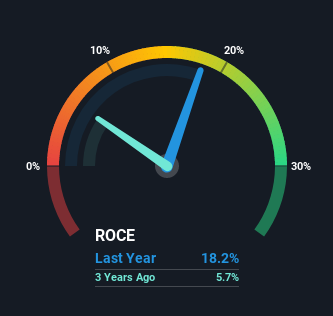Finding a business that has the potential to grow substantially is not easy, but it is possible if we look at a few key financial metrics. Firstly, we'll want to see a proven return on capital employed (ROCE) that is increasing, and secondly, an expanding base of capital employed. Put simply, these types of businesses are compounding machines, meaning they are continually reinvesting their earnings at ever-higher rates of return. So when we looked at Brill Shoe Industries (TLV:BRIL) and its trend of ROCE, we really liked what we saw.
What is Return On Capital Employed (ROCE)?
For those who don't know, ROCE is a measure of a company's yearly pre-tax profit (its return), relative to the capital employed in the business. Analysts use this formula to calculate it for Brill Shoe Industries:
Return on Capital Employed = Earnings Before Interest and Tax (EBIT) ÷ (Total Assets - Current Liabilities)
0.18 = ₪62m ÷ (₪491m - ₪148m) (Based on the trailing twelve months to September 2021).
So, Brill Shoe Industries has an ROCE of 18%. In absolute terms, that's a satisfactory return, but compared to the Luxury industry average of 10% it's much better.
View our latest analysis for Brill Shoe Industries

Historical performance is a great place to start when researching a stock so above you can see the gauge for Brill Shoe Industries' ROCE against it's prior returns. If you'd like to look at how Brill Shoe Industries has performed in the past in other metrics, you can view this free graph of past earnings, revenue and cash flow.
What Does the ROCE Trend For Brill Shoe Industries Tell Us?
Brill Shoe Industries has recently broken into profitability so their prior investments seem to be paying off. The company was generating losses five years ago, but now it's earning 18% which is a sight for sore eyes. Not only that, but the company is utilizing 79% more capital than before, but that's to be expected from a company trying to break into profitability. This can indicate that there's plenty of opportunities to invest capital internally and at ever higher rates, both common traits of a multi-bagger.
In another part of our analysis, we noticed that the company's ratio of current liabilities to total assets decreased to 30%, which broadly means the business is relying less on its suppliers or short-term creditors to fund its operations. This tells us that Brill Shoe Industries has grown its returns without a reliance on increasing their current liabilities, which we're very happy with.
In Conclusion...
In summary, it's great to see that Brill Shoe Industries has managed to break into profitability and is continuing to reinvest in its business. And investors seem to expect more of this going forward, since the stock has rewarded shareholders with a 95% return over the last five years. So given the stock has proven it has promising trends, it's worth researching the company further to see if these trends are likely to persist.
On a separate note, we've found 3 warning signs for Brill Shoe Industries you'll probably want to know about.
While Brill Shoe Industries may not currently earn the highest returns, we've compiled a list of companies that currently earn more than 25% return on equity. Check out this free list here.
Valuation is complex, but we're here to simplify it.
Discover if Brill Shoe Industries might be undervalued or overvalued with our detailed analysis, featuring fair value estimates, potential risks, dividends, insider trades, and its financial condition.
Access Free AnalysisHave feedback on this article? Concerned about the content? Get in touch with us directly. Alternatively, email editorial-team (at) simplywallst.com.
This article by Simply Wall St is general in nature. We provide commentary based on historical data and analyst forecasts only using an unbiased methodology and our articles are not intended to be financial advice. It does not constitute a recommendation to buy or sell any stock, and does not take account of your objectives, or your financial situation. We aim to bring you long-term focused analysis driven by fundamental data. Note that our analysis may not factor in the latest price-sensitive company announcements or qualitative material. Simply Wall St has no position in any stocks mentioned.
About TASE:BRIL
Brill Shoe Industries
Designs, manufactures, imports, procures, markets, and sells footwear and clothing products, and fashion accessories in Israel.
Good value with mediocre balance sheet.
Market Insights
Community Narratives


Recently Updated Narratives


MINISO's fair value is projected at 26.69 with an anticipated PE ratio shift of 20x


Fiverr International will transform the freelance industry with AI-powered growth

Constellation Energy Dividends and Growth
Popular Narratives


MicroVision will explode future revenue by 380.37% with a vision towards success


NVDA: Expanding AI Demand Will Drive Major Data Center Investments Through 2026



